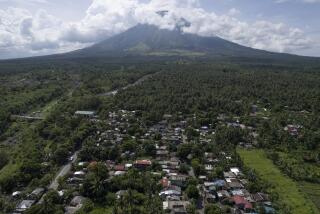Mt. Pinatubo Is Still Making Volcanic Havoc : Philippines: Two years after a major eruption, mudflows periodically wipe out villages and people. But many of the area’s residents simply refuse to leave.
- Share via
SAN MARCELINO, Philippines — When Gloria Falloran’s husband comes home from sea next year, he will find his house and village wiped off the earth.
Falloran, a 33-year-old school librarian from Santa Fe village, was cooking the evening meal one stormy afternoon when she heard what sounded like the roar of a thousand bulldozers advancing on her house.
In minutes, 90% of the village of 400 houses had disappeared.
Nearly everything, including the small schoolhouse where Fallaron worked, was swamped by mudflows from Mt. Pinatubo volcano, even though the mountain was 25 miles away.
Eleven villagers died on that day in October, including a team of engineers who were carried away by waves of mud and never seen again.
“My husband is at sea. When he comes home, he’ll find that Santa Fe is gone,” said Falloran, who now lives in a cluster of tents on a hill overlooking the ruins of her village in San Marcelino town, 60 miles northwest of Manila.
Until Pinatubo, dormant for six centuries, erupted in June, 1991, in one of the century’s biggest volcanic blasts, San Marcelino was a verdant community where the land was rich, the mountains lush with trees and the rivers teemed with fish.
Mudflows that followed the eruption swallowed up homes, churches, schoolhouses, plantations and a gold mine, and turned several villages into virtual deserts.
In one village, only the roof of an animal breeding station protrudes from the ground.
Pinatubo is back in slumber, but two years after the eruption, the 5,700-foot mountain continues to wreck the lives of thousands of Filipinos.
The eruption dumped billions of tons of rocks and ash on Pinatubo’s slopes. When heavy rains come, they turn into raging rivers of mud that can obliterate everything in their path.
Scientists say up to 353 billion cubic feet of volcanic debris, called “lahar,” are piled up on the slopes.
It would take 35 million dump trucks to clear away the ash and sand that is still red-hot in some places.
Flying over Pinatubo, gray-white lahar can be seen stretching into the distance, but experts say only 40% of the ash has been washed off the mountain.
This means villages around Pinatubo will be threatened by mudflows for at least another five years.
Defense chief Renato de Villa has ordered the evacuation of women, children and old people in San Marcelino and the nearby town of Castillejos which lie in the path of mudflows.
The mud that engulfed Santa Fe on Oct. 5 was so powerful it toppled a half mile stretch of an 11-mile long dike built to protect Zambales province from disaster.
But at least 10,000 people in seven villages that would be directly threatened by mudflows during the next tropical storm refuse to leave.
“The dike is no longer defensible but people still refuse to evacuate,” Mayor Jose Rodriguez said. “They will go when heavy rains come but they will come back when the sun shines again.”
Villagers say they do not want to stay in unsanitary evacuation camps where they have to queue up for food.
Others will not go until the government gives them a permanent place to resettle, complete with jobs.
“It’s not that they are irrational. It’s a matter of where their roots are. . . . People have such attachments to home and land,” said sociologist Cynthia Bautista.
“In developed countries, where you can predict more or less what will happen, there are more rational ways. . . . In countries where people do not feel a sense of control of their lives because of poverty, you tend to gamble.”
Of the 370 families who lived in Rabanes before the 1991 eruption, only 40 are left.
Dozens of houses were buried under ash during the eruption, while mudflows last year swamped most of the others.
Rabanes councilman Freddie Ragudo says he’ll take his chances with the next lahar emergency.
“I can run. Besides, who will look after my two carabaos (water buffaloes) and my seven cows?”
A street away, Conrado Madrid Sr., a 65-year-old retired animal breeder, was crying like a little boy.
He tell about how he had spent his $3,500 retirement pay from the government to build his dream bungalow.
His dream now lies half buried in mud.
An army truck piled with pots, a broken sewing machine and a few other items that Madrid had salvaged from the mud stood outside his house, ready to take his family away.
Madrid, tears streaming down his cheeks, is staying behind.
“I lost everything. I toiled for 34 years and now this. . . . This is part of my life. I cannot leave this house behind.”
More to Read
Sign up for Essential California
The most important California stories and recommendations in your inbox every morning.
You may occasionally receive promotional content from the Los Angeles Times.













